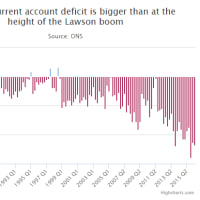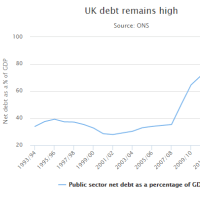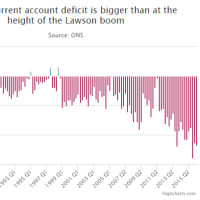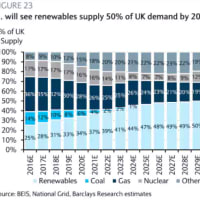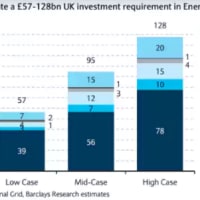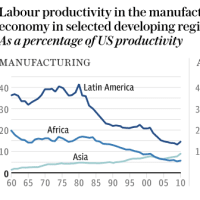Technology revolution in nuclear power could slash costs below coal
(原発技術革新で石炭のコストを下回れる可能性)
By Ambrose Evans-Pritchard
Telegraph: 9:23PM BST 24 Sep 2014


(原発技術革新で石炭のコストを下回れる可能性)
By Ambrose Evans-Pritchard
Telegraph: 9:23PM BST 24 Sep 2014
Scientists have already designed better reactors based on molten salt technology that promise to slash costs by half or more
専門家は50%以上のコスト削減を確約する溶塩技術に基づくより高性能な原子炉を既に設計済みです。
The cost of conventional nuclear power has spiralled to levels that can no longer be justified. All the reactors being built across the world are variants of mid-20th century technology, inherently dirty and dangerous, requiring exorbitant safety controls.
既存の原子力発電のコストはもはや正当化出来ない水準まで急激に上昇しました。
世界中に作られた全ての原子炉は20世紀中盤の技術に基づくものであり、本質的に汚い上に危険で法外な安全管理を要します。
This is a failure of wit and will. Scientists in Britain, France, Canada, the US, China and Japan have already designed better reactors based on molten salt technology that promise to slash costs by half or more, and may even undercut coal. They are much safer, and consume nuclear waste rather than creating more. What stands in the way is a fortress of vested interests.
これは知恵と意志の敗北です。
英国、フランス、カナダ、米国、中国、日本の科学者は、50%以上のコスト削減を確約し、恐らく石炭火力発電のコストすら下回る可能性を持つ溶塩技術に基づく、より高性能な原子炉を既に設計しています。
これらは遥かに安全で、放射性廃棄物を生み出す代わりに消費します。
障害は、既得権益の要塞です。
The World Nuclear Industry Status Report for 2014 found that 49 of the 66 reactors under construction - mostly in Asia - are plagued with delays, and are blowing through their budgets.
2014年の世界原子力産業現状報告書は、現在建設が(主にアジアで)進められている66基の原発の内49基は工期が長引いている上に、予算も超えていることを伝えています。
Average costs have risen from $1,000 per kilowatt hour to around $8,000/kW over the past decade for new nuclear, which is why Britain could not persuade anybody to build its two reactors at Hinkley Point without fat subsidies and a "strike price" for electricity that is double current levels.
原子力発電の平均コストはこの10年間で1,000ドル/キロワット時から約8,000ドルに上昇しましたが、だからこそ英国は、多額の補助金と現在の2倍に上る電力「行使価格」なしにヒンクリー・ポイントでの原発2基の建設について、誰も説得出来ないのです。
All five new reactors in the US are behind schedule. Finland's giant EPR reactor at Olkiluoto has been delayed again. It will not be up and running until 2018, nine years late. It was supposed to cost €3.2bn. Analysts now think it will be €8.5bn. It is the same story with France's Flamanville reactor.
米国の新規原発5基は全て遅れています。
フィンランドはOlkiuotoの巨大ERP原子炉も再び遅れています。
予定よりも9年遅い2018年まで完成、稼働することはないでしょう。
建設コストは32億ユーロのはずでした。
アナリストの現在の試算は約85億ユーロです。
フランスのFlamanville原子炉も同様です。
We have reached the end of the road for pressurised water reactors of any kind, whatever new features they boast. The business is not viable - even leaving aside the clean-up costs - and it makes little sense to persist in building them. A report by UBS said the latest reactors will be obsolete by within 10 to 20 years, yet Britain is locking in prices until 2060.
新型についてどれだけ自慢されようが関係なく、僕らはあらゆる種類の加圧水型原子炉の道の終わりに到達したのです。
このビジネスは持続不可能です(浄化コストを別としても)。
また、これを作り続けることは殆ど不条理です。
UBSのレポートによれば、最新型原子炉は10-20年以内に時代遅れになるとのことですが、英国は2060年まで価格を固定しようとしています。
The Alvin Weinberg Foundation in London is tracking seven proposals across the world for molten salt reactors (MSRs) rather than relying on solid uranium fuel. Unlike conventional reactors, these operate at atmospheric pressure. They do not need vast reinforced domes. There is no risk of blowing off the top.
ロンドンのアルビン・ワインバーグ財団は固形ウランに依存するのではなく、世界の溶融塩原子炉に関する7つの提案をトラッキングしています。
従来型の原子炉と異なり、これらの原子炉は大気圧で稼働します。
また、巨大な強化ドームも必要ありません。
吹き飛ぶリスクがないのです。
The reactors are more efficient. They burn up 30 times as much of the nuclear fuel and can run off spent fuel. The molten salt is inert so that even if there is a leak, it cools and solidifies. The fission process stops automatically in an accident. There can be no chain-reaction, and therefore no possible disaster along the lines of Chernobyl or Fukushima. That at least is the claim.
更に効率も良くなっています。
核燃料の30倍を燃焼し、使用済み燃料を放出出来ます。
溶塩は不活性なので、リークしても冷えて固まります。
事故の際、分裂は自動的に停止します。
連鎖反応はないので、チェルノブイリや福島のような大惨事の可能性はありません。
少なくとも、そう言われています。
The most revolutionary design is by British scientists at Moltex. "I started this three years ago because I was so shocked that EDF was being paid 9.25p per kWh for electricity," said Ian Scott, the chief inventor. "We believe we can achieve parity with gas (in the UK) at 5.5p, and our real goal is to reach 3.5p and drive coal of out of business," he said.
最も斬新な設計はMoltexの英国人科学者によるものです。
「3年前にこれを始めました。EDFが9.25ペンス/キロワット時も電気代を払っているのに衝撃を受けたからです」とチーフ・インベンターのイアン・スコット博士は言いました。
「5.5ペンスでガスと同額に出来ると思います(注:英国内の価格)。目標は3.5ペンスで、石炭を発電ビジネスから追い出すことです」
The Moltex project can feed off low-grade spent uranium, cleaning up toxic waste in the process. "There are 120 tonnes of purified plutonium from nuclear weapons in Britain. We could burn that up in 10 to 15 years," he said. What remained would be greatly purified, with a shorter half-life, and could be left safely in salt mines. It does not have to be buried in steel tanks deep underground for 240,000 years. Thereafter the plant could be redesigned to use thorium, a cleaner fuel.
Moltexプロジェクトは品質の低い使用済みウランを使うことが可能で、その過程で有毒廃棄物を綺麗にすることが出来ます。
「英国には核兵器の精製されたプルトニウムが120トンあります。10-15年でこれを燃やすことが出来るでしょう」
残留物は一層精製されて半減期がより短くなっており、岩塩坑に安全に廃棄出来ます。
鋼のタンクに入れて24万年も地中深く埋めておく必要はないのです。
The reactor can be built in factories at low cost. It uses tubes that rest in molten salt, working through a convection process rather than by pumping the material around the reactor. This cuts corrosion. There is minimal risk of leaking deadly cesium or iodine for hundreds of miles around.
また、低価格で工場内に作ることも出来ます。
溶塩に入れたチューブを使い、燃料を原子炉の中をポンプで回すのではなく、対流させて発電します。
危険なセシウムやヨウ素が周囲数百マイルに漏れ出すリスクも最小限です。
Transatomic Power, in Boston, says it can build a "waste-burning reactor" using molten salts in three years, after regulatory approval. The design is based on models built by US physicist Alvin Weinberg at Oak Ridge National Laboratory in the 1960s, but never pursued - some say because the Pentagon wanted the plutonium residue for nuclear warheads.
ボストンのトランスアトミック・パワーは、溶塩を用いる「廃棄物燃焼型原子炉」を当局の承認を得てから3年以内に完成出来るとしています。
1960年代に米国人物理学者、アルビン・ワインバーグ博士がオークリッジ国立研究所で作りながら一度も研究が進められなかったモデルに基づいて設計されています。
国防総省が核弾頭用に使用済み核燃料抽出プルトニウムを欲しがったからだと言う人もいます。
It would cost $2bn (overnight cost) for a 550-megawatt plant, less than half the Hinkley Point project on a pro-rata basis. Transatomic says it can generate 75 times as much electricity per tonne of uranium as a conventional light-water reactor. The waste would be cut by 95pc, and the worst would be eliminated. It operates in a sub-critical state. If the system overheats, a plug melts at the bottom and salts drain into a cooling basin. Again, these are the claims.
発電量550メガワットの原発の建設コストは20億ドル(金利抜き)と、比例すればヒンクリー・ポイント原発の半分以下です。
トランスアトミック社は、ウラン1トン当たりの発電量は、既存の水圧型原子炉の75倍に上るだろうとしています。
廃棄物の量は95%減少しますし、最悪の部分はなくなります。
未臨界状態で稼働します。
システムが過熱した場合、底の栓が融けて塩は冷却層に流れ込みます。
先と同様、そう言われています。
The most advanced project is another Oak Ridge variant designed by Terrestrial's David LeBlanc, who worked on the original models with Weinberg. It aims to produce power by the early 2020s from small molten salt reactors of up to 300MW, for remote regions and industrial plants. "We think we can take on fossil fuel power on a pure commercial basis. This is a revolution for global energy," said Simon Irish, the company's chief executive.
最先端のプロジェクトもオークリッジ系で、テレストリアル社のデイヴィッド・レブロン氏の設計によるものですが、彼はワインバーグ博士と共に原型モデルを研究した人物です。
目標は、2020年代初頭までに辺境地や工場向けに、小型溶融塩炉で最大300メガワットを発電することです。
「純粋にコマーシャル・ベースで化石燃料ベースの電気に勝てると思っています。これは世界のエネルギーにとって革命ですよ」と同社のサイモン・アイリッシュCEOは言いました。
Toronto-based Terrestrial prefers the "dry tinder" of uranium rather than the "wet wood" of thorium, which needs a blowtorch to get started and keep going, typically plutonium 239. But it could use either fuel.
トロントに拠点を置くテレストリアル社は、燃え始めるために、そして燃え続けさせるために火炎噴射が必要なトリウムという「湿った薪」よりも、ウランという「乾いた薪」の方を好んでいます(一般的にはプルトニウム239)。
しかしいずれも利用出来ます。
A global race is under way, with the Chinese trying everything at the Shanghai Institute of Nuclear and Applied Physics, reportedly working under "warlike" pressure. They have brought forward their target date for a fully-functioning molten salt reactor - using thorium - from 25 to 10 years.
世界的な競争は進行中であり、中国勢は中国科学院上海応用物理研究所で、伝えられるところでは「戦争のような」プレッシャーの下で、ありとあらゆることを試みています。
彼らは(トリウムを使用する)溶融塩炉の完成時期を25年前倒しして10年としました。
Ian Scott, at Moltex, originally planned to sell his technology to China, having given up on the West as a lost cause. He was persuaded to stay in Britain, and is talking to ministers. "The first stage will cost around £1bn, to get through the regulatory process and build a prototype. Realistically, only the government can do this," he said.
Moltexのイアン・スコット博士はもともと、西側に見切りをつけて中国に自分の技術を売るつもりでした。
彼は英国に残ることを説得され、今では閣僚達に語りかけています。
「承認手続きを終えてプロトタイプを作るまでの第一段階のコストは約10億ポンドです。現実的に言って、これが出来るのは政府だけですよ」と同氏は言います。
A state-venture of such a kind should not be ruled out. The travails of Hinkley Point show that the market cannot or will not deliver nuclear power on tolerable terms. The project has degenerated into a bung for ailing foreign companies. We have had to go along with it as an insurance, because years of drift in energy policy have left us at an acute risk of black-outs in the 2020s.
このような国による事業の可能性を排除すべきではありません。
ヒンクリー・ポイント原発の苦労は、マーケットは許容可能な条件で原発を実現することも出来なければ、そうすることもないということを見せつけてみます。
同プロジェクトは経営難にあえぐ外資の餌に成り下がりました。
何年間もエネルギー政策が固まらなかったために2020年代には停電が起こるリスクが差し迫っているのですから、これは保険として継続しなければなりません。
There is no reason why Britain cannot seize the prize of molten salt reactors, if necessary funded entirely by the government - now able to borrow for 10 years at 2.5pc - and run like a military undertaking. A new Brabazon Committee might not go amiss.
必要なら政府が資金を100%供与して(今なら10年2.5%で借りられます)軍事案件のように運営することによって、英国が溶融塩炉という宝物を手に入れることは可能です。
新ブラバゾン委員会なら間違いはないかもしれません。
The nation still has world-class physicists. The death of Britain's own nuclear industry has a silver lining: there are fewer vested interests in the way. We start from scratch. The UK's "principles-based" philosophy of regulation means that a sudden pivot in technology of this kind could be approved very fast, in contrast to the America's "rules-based" system. "I would never even think of doing it in the US," said Dr Scott.
この国には今も世界屈指の物理学者がいます。
英国独自の原子力産業の死には希望の光があります。
つまり、そのような既得権益が少ないということです。
僕らはゼロから始めることになります。
英国の「信条に基づく」規制哲学は、米国の「規則に基づく」システムと異なり、この種の唐突な技術革新も極めて迅速に承認出来る可能性を示唆しています。
「米国でこれをやるとか、考えたこともありませんね」とスコット博士は言いました。
It would be hard to argue that any one of the molten salt technologies would be more expensive than arrays of wind turbines in the Atlantic. Indeed, there is a high likelihood that the best will prove massively cheaply on a kW/hour basis.
溶融塩技術のいずれかが大西洋に並ぶ風力発電タービンよりも高価だとは言い難いでしょう。
そう、キロワット時で計算すると、最善策こそが最も安価である可能性が高いのです。
Such a project would kickstart Britain's floundering efforts to rebuild industry. It would offer some hope of plugging a chronic and dangerously high current account deficit, already 5pc of GDP even before North Sea oil and gas fizzles out. It is fracking on steroids for import substitution.
そのようなプロジェクトは、難航中する我が国の産業再建努力を勢いづけるでしょう。
北海油田の石油とガスが枯渇する前ですらGDPの5%に達している、慢性的かつ危険なほどの高水準に達した経常赤字を改善する希望を与えることでしょう。
輸入代替にとっては強化版フラッキングです。
Britain split the atom at the Cavendish Laboratory in Cambridge in 1911. It opened the world's first commercial reactor at Calder Hall in 1956. Surely it can rise to the challenge once again. If not, let us cheer on the Chinese.
英国は1911年にケンブリッジ大学のキャベンディッシュ研究所で原子を分裂させました。
1956年には世界最初の商業用原子力発電所を開設しました。
英国はこの課題に再び立ち向かえるはずです。
立ち向かえないのなら、中国勢を応援するとしましょうか。











